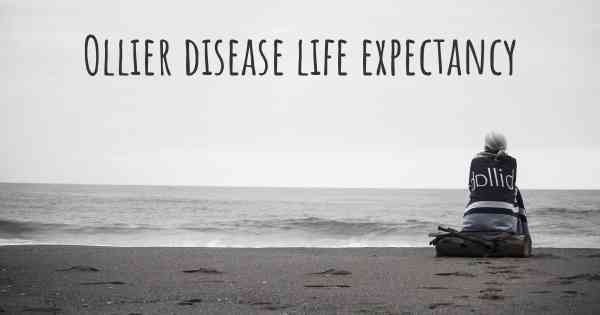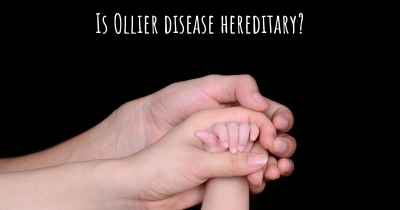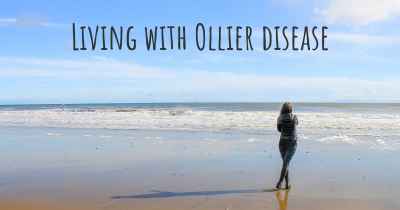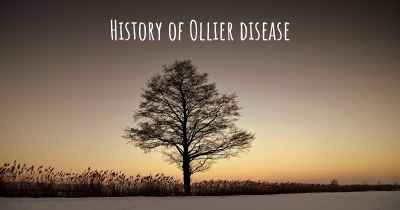What is the life expectancy of someone with Ollier disease?
Life expectancy of people with Ollier disease and recent progresses and researches in Ollier disease

Ollier disease is a rare non-hereditary disorder characterized by the development of multiple benign bone tumors called enchondromas. The life expectancy of individuals with Ollier disease can vary depending on various factors such as the location and severity of the tumors, as well as any associated complications. While there is limited data on life expectancy specifically for Ollier disease, it is generally considered to be a non-life-threatening condition. However, the presence of multiple tumors can lead to skeletal deformities, limb length discrepancies, and an increased risk of fractures. Regular monitoring and appropriate medical management are crucial to ensure the best possible quality of life for individuals with Ollier disease.
Ollier disease, also known as enchondromatosis, is a rare non-hereditary disorder characterized by the development of multiple benign cartilage tumors called enchondromas. These tumors primarily affect the bones of the limbs, particularly the long bones, and can lead to various complications depending on their location and size.
As Ollier disease is a rare condition, there is limited data available regarding the life expectancy of individuals affected by this disorder. The prognosis can vary significantly depending on several factors, including the extent and distribution of the enchondromas, their potential for malignant transformation, and the associated complications.
Enchondromas:
Enchondromas are typically benign tumors that arise from cartilage within the bones. They can cause bone deformities, growth disturbances, and skeletal abnormalities. The severity and progression of these tumors can vary widely among individuals with Ollier disease. Some individuals may have only a few enchondromas, while others may have numerous tumors affecting multiple bones.
Malignant transformation:
One of the significant concerns associated with Ollier disease is the potential for malignant transformation of the enchondromas. While most enchondromas remain benign, a small percentage can undergo malignant changes and develop into a type of bone cancer called chondrosarcoma. The risk of malignant transformation varies, but it is generally estimated to be around 25% over a person's lifetime.
Complications:
The complications arising from Ollier disease can significantly impact an individual's health and life expectancy. Some of the potential complications include:
- Fractures: Enchondromas can weaken the affected bones, making them more prone to fractures. Fractures can lead to pain, disability, and further complications.
- Deformities: Enchondromas can cause bone deformities, leading to limb length discrepancies, angular deformities, and functional impairments.
- Growth disturbances: Enchondromas can disrupt the normal growth of bones, resulting in unequal limb lengths and other growth abnormalities.
- Chondrosarcoma: The risk of chondrosarcoma development increases in individuals with Ollier disease. Chondrosarcoma is a malignant bone tumor that can significantly impact life expectancy and require aggressive treatment.
Management and treatment:
There is no cure for Ollier disease, and treatment primarily focuses on managing the associated complications and monitoring for potential malignant transformation. Regular imaging studies, such as X-rays and MRIs, are essential to monitor the growth and behavior of the enchondromas.
If complications arise, appropriate interventions may be necessary. Fractures may require surgical fixation, while limb length discrepancies and deformities may be managed with orthopedic interventions like limb lengthening procedures or corrective osteotomies.
Life expectancy:
Due to the rarity of Ollier disease and the significant variability in its presentation and complications, it is challenging to provide a specific life expectancy for individuals with this condition. The prognosis can vary widely depending on the severity of the disease, the presence of complications, and the potential for malignant transformation.
It is crucial for individuals with Ollier disease to receive regular medical follow-up and appropriate management of complications to optimize their quality of life and potentially improve their prognosis. Early detection and treatment of any potential malignant transformation are vital in ensuring the best possible outcomes.
There is a report of 5%-50% of cases that have experienced malignancy
Posted May 18, 2017 by Sarah Jane 5070
Posted Feb 24, 2017 by Dante 1000








